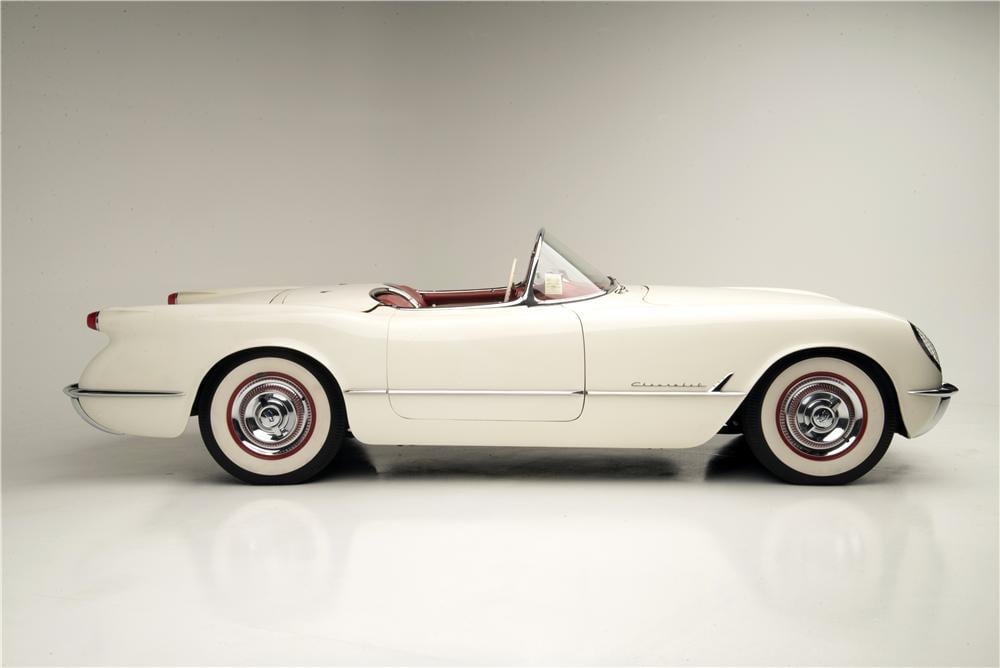Corvette History 
Select a year and a model to view the vast history of Corvettes.
Corvette Profile:

”Don’t Let The Stars Get In Your Eyes” was a Number 1 song in 1953, but Chevrolet Motor Div. was perfectly content to put stars in car buyers’ eyes when it brought a dream car to life as the 1953 Corvette. In fact, film stars like John Wayne were provided with early examples in hope that their fame would generate publicity for the new “All-American Sports Car.” Dave Garroway, a TV celebrity of the era who was know as a sports-car buff, praised the new model in a sales promotion filmed called “Halls of Wonder.”
A prototype ‘Vette was shown at the 1953 GM Motorama in New York. The sleek roadster was rushed to the public. The first production Corvette was built on June 30, 1953 in Chevrolet’s Flint, MI assembly plant. In fact, all ‘53s were constructed there, in an area at the rear of the customer delivery garage on Van Dyke Ave. It would not be until 1954 that manufacturing of the new sports car shifted to a factory in St. Louis, MO.
Chevy expected to make 1,000 Corvettes per month in St. Louis and predicted that 10,000 per year could be sold by its dealers. It took more than a few years to prove that; the first Corvette to achieve five figure production numbers was the 1960 model.
Chevrolet’s original plan was to build 300 fiberglass-bodied Corvettes and switch to a steel bnody. But the new technology captured public attention. “Corvette Shows The Way For Plastic Cars” read the headline of a Life magazine article showing photos of the 54 plastic parts and of a workman lifting the 35-lb hood and fender section by himself. In addition, fiberglass bodies were cheaper to build. According to one estimate, GM paid $400,000 to make 300 Corvette bodies that would have cost $4.5 million to make in steel!
The Corvette had a chrome-framed grille with 13 heavy vertical chrome bars and recessed headlights that were protected by chromed wire-screen. Like most true sports cars of the era, it was a genuine “roadster” – an open car with no side windows. In fact, it did not even have outside door handles. One of the earliest wraparound windshields was used. At the rear were protruding fender-integrated taillights.
The Corvette’s interior featured a Powerglide two-speed automatic transmission, a rather radical departure from standard sports-car practice. However, gear shifting was still accomplished via a floor-mounted lever. Oil pressure, battery, water temperature and fuel gauges were fitted in the dashboard, along with a tachometer and a clock.
Each 1953 model was birtually hand-built and a lot of minor changes were made during the run. All of the first-year Corvettes were Polo White with Sportsman Red interiors. According to an article published in Life, this was because “white is the plastic’s normal color and a demand for other colors has not materialized.” The magazine reported Chevrolet’s claim that Corvettes would be easy to repair. “If the tough plastic is punctured in an accident it can usually be patched like new with a blowtorch for a couple of dollars.”
All ‘Vettes had black canvas convertible tops that manually folded into a storage space behind the seats. Other 1953-only features included special valve covers, a one-piece carburetor linkage and a small trunk mat. Short exhaust extensions were used on all ’53 (and early ‘54s), since the cars were prone to drawing exhaust fumes inside through the vent windows. A black oilcloth window storage bag was provided to protect the 1953 Corvette’s removable plastic side windows when they were stowed in the trunk.
The Corvette’s $3,498 list price included a “hopped-up” version of Chevrolet’s 235.5-cid in-line six-cylinder engine. This cast-iron, overhead-valve power plant was well known by its “Stovebolt Six” nickname. It combined a 3.56 x 3.96-inch bore and stroke, an 8.0:1 compression ratio and three Carter Type YH one-barrel carburetors to generate 150hp at 4200rpm. A single breaker-point ignition system was used.
Tipping the scales at 2,705 lbs, the Corvette rode a 102-inch wheelbase and measured inches end-to-end. It had 57-inch front tread and a 58.8-inch rear tread. The 6.70 x 15 tires were mounted on steel disk wheels. Front suspending was by coil springs, with tubular shock absorbers and a stabilizer bar. Leaf springs were fitted at the rear, in combination with a tubular shocks and a solid rear axle. Drum brakes were found at all four corners. A 3.55:1 rear axle was standard. A six-volt electrical system was supplied.
In addition to being the first Corvette, the 1953 model is the rarest one ever made – that is, of you don’t count the one 1983 pilot model that Chevy built or some rare option packages. Model-year production for ’53 peaked at 300. About 200 of the 300 Corvettes made in 1953 are known to still exist today. Calendar-year sales were also 300 cars.
Zora Arkus-Duntov joined Chevrolet on May 1, 1953. Duntov believed that a combination of passion and practicality sold cars. He felt that sporty cars like the Corvette lacked practicality and therefore had to have extra emotional appeal to garner sufficient sales. He thought that higher performance could create such appeal. Duntov would soon become chief engineer of the Corvette. By making it a V-8 powered model and adding other upgrades, he came to play a major role in shaping its destiny and success.